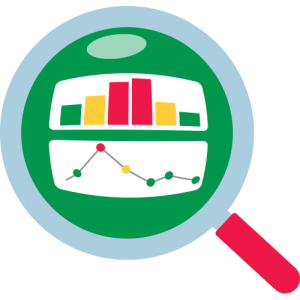Phase 2 – Investigate the climate problem
In this phase, students investigate the climate problem they identified in Phase 1. For that students will collect suitable data, compile this data, analyse their findings and draw conclusions.
During Phase 2, ESA or, where applicable, the National Coordinator will organize online events in which teams can “Ask a Scientist” and receive background information and tips.
The steps involved in phase 2:
Collect Data
Phase 2 is the time to begin gathering the data to answer the research question which was identified in Phase 1. It is important that any data collected is recorded and, to this end, students could have a logbook or recording sheets where relevant information is written down.
The Earth observation data used by students for the Climate Detectives project may be ground measurements OR satellite data. Students may also use both types of data in their investigations.
Ground data
This is the data collected in situ by the students. Important information to be included in a logbook, recording sheet or spreadsheet could include:
 Date
Date
Time of day
Location (map & GPS)
Climate variable (temperature, humidity, wind speed, precipitation, cloud cover)
Observation records
Measurements/counts
Survey responses
Field experiment data
Laboratory experiment data
Evidence of students at work may also be documented by means of:
Photographs of location where data is being collected
Videos
Photographs of team members at work (make sure to follow GDPR rules for your school)
Screenshots of the data being collected
Labelled sketches of experiments in the field or in the laboratory
This may be useful in communicating the work done by the students during Phase 3 of the project.
Accessing and using satellite data
There is a fleet of satellites orbiting Earth, collecting data and monitoring climate from space (remotely). These satellites use a wide variety of sensors to provide a bank of current and historical data on a wide range of climate variables.
Students have access to data related to land temperature, air quality, vegetation patterns, ice cover, oceans and many more. Data and satellite images can be accessed, and the data retrieved may be used to answer the research question which was identified in Phase 1 of the Climate Detectives project.
If students are using satellite data and images to research their climate problem, they should keep detailed notes including:
Cite the link to the applications being used
Date on which they searched for the data
Area searched
Record if it is current data or historic data
Retrieve and save the data
Download and save satellite images they want to use
Organise and manage data

The first step to organise the data is to compile it into a form that is easy to interpret and where relationships between variables can be readily observed.
Students can compile clearly labelled tables of data. These can then be used to create different types of graphs to show their data and allow patterns, trends and similarities/differences to be seen more clearly, for example:
Line graphs
scatter diagrams
trend graphs
bar charts
pie charts
When constructing graphs, students should include the following:
title of graph
clearly labelled axes
units of measurements
appropriate scaling
Students may include simple statistical/mathematical calculations such as sample size, mean (average), median and range.
These tables and graphs will be useful in Phase 3 of the project, when students are sharing their results and communicating their findings.
Analyse data and draw conclusions

The data collected and compiled will form the basis for discussion, reasoning and reflection about the team project. Students may use the following questions to evaluate whether their findings answer their research question:
Are there obvious trends/patterns?
What might the trends/patterns mean?
Are there any disparities or something that looks incorrect? Can they be explained?
Can any conclusions be drawn from the findings?
Are there any limitations to the conclusions?
Is the research question answered sufficiently?
Is further research required?
Concluding is a difficult part of the research process and the distinction between results and conclusions is not always clear. The conclusion should try to answer the research question and the results can be displayed, when applicable, in a graph, table or pie chart as seen in the section before.
You can find more information about phase 2 and the different steps in the teacher guide

